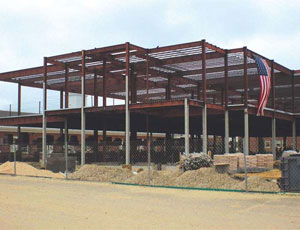In a roaring development cycle, size is an edge. The construction company with a monster lineup of staff, resources, equipment, and experience nearly always has a jump snaring attractive projects – benefiting from economies of scale and fatter profit potential. Smaller players generally have to find niches and exploit them rather than compete against larger contractors.


But in lean times, the equation appears more balanced. Big projects in the $100 million-plus range are rarer and firms of all sizes end up in a scrum for smaller projects. And in that setting, being small – or at least being able to “play small” – can offer advantage, say construction management executives in the New York, New Jersey, and Connecticut markets.
They say the game has certainly changed in the region as backlogs that kept firms working in 2009 start to clear. The shakeout has brought many new entrants to bidding pools for smaller projects – often from larger contractors putting in low bids to keep the cash flowing.
“I wouldn’t say that there’s more smaller projects, but certainly there is more competition for them,” says Jim Scully, principal of Scully Construction, an interiors and general contracting firm based in North White Plains, N.Y.
But smaller contractors are holding their own, says Kevin Dunathan, v.p. of operations at Stalco Construction, a construction manager in Islandia, N.Y., that doubled its 2008 volume to handle $80 million worth of commercial and institutional building projects last year. Dunathan says Stalco’s smaller scale is an advantage, because the two principals and other senior executives are very hands on. “Everyone feeds off of that involvement,” he adds.
A strong track record managing jobs under $50 million – and even under $15 million – also plays in the favor of smaller contractors that treat such jobs as their “bread and butter,” Scully says. His firm largely feasts on efforts in the $500,000 to $5 million range.
Some big construction managers also primed to win smaller jobs, particularly firms that stick to their specialties and longtime clients. Some – such as F.J. Sciame Construction – have always kept active in smaller efforts, avoiding the need to retool or stretch their résumé to fit a new environment.
But the downturn has clearly exposed firms ready for today’s market and others only scrounging. “It has been an eye-opening experience just going through the past year and a half seeing how different firms have reacted to the challenges of the current economy,” says Joseph Mizzi, Sciame’s president.
Small is Big The clear result of the down market is a pullback on project starts for megaprojects of the recent boom – the public infrastructure expansions, stadiums, office towers, or residential complexes. While smaller jobs may also be down, they suddenly are more prominent.
“Of the projects that we’re seeing come across our desk, there is a higher percentage in the $20 million [to] $50 million size,” Sciame’s Mizzi says. There are definitely fewer jobs available valued more than $50 million, he adds.
The same phenomenon is present in the civil market, says Jay Price, executive v.p. of the Conti Group, a contractor based in South Plainfield, N.J. “The big jobs are coming out a little bit slower than they were about a year ago, and the pricing has been, especially in New Jersey, extremely – I guess the professional word is ‘competitive,’” Price says. “The unprofessional word would be ‘bloodbath’ – people just taking work for cash flow, for no profit. Some of them are bidding without putting their equipment costs in.”
The market’s character has simply changed, says Denise Richardson, managing director of the General Contractors Association of New York, which represents heavy contractors. “New billion dollar jobs aren’t out there any more,” she says. “So it’s not that people are looking for smaller projects to keep busy, it’s that the profile of all projects has changed.”
That means the agencies that were letting $60 million water treatment plant expansion projects two years ago are instead churning out smaller “core” water and sewer main “state of good repair” instead, Richardson says.
In some cases, large plans are simply being chopped down. “We’re seeing projects being rolled out in phases,” Mizzi says. “On the surface it could be a $40 million or $50 million project, but the way it’s being planned, it’s being rolled out in two or three phases.”
The menu of small projects in the region covers substantial ground. Scully is now working an $11 million two-story, 20,000-sq-ft headquarters and exhibition space in Pocantico Hills, N.Y., for Historic Hudson Valley, a museum and educational organization. It broke ground last fall and is set to finish this October.
Stalco is also taking on new jobs, including a $7.3 million, 60,000-sq-ft interior fit-out for a Platinum LEED community center in Manhattan’s Battery Park district. It also is managing a $10 million capital improvements phase for Three Village Central School District in East Setauket and Stony Brook, N.Y., a contract on which the firm was already running a separate $20 million phase.
Various other small projects are getting underway, including a $3 million to $5 million Holocaust Memorial in Atlantic City that was seeking an architect in early spring and a $9.6 million, 18,000-sq-ft cultural and arts center at the Kalahari Condominium in New York’s Harlem neighborhood. The arts center was expected to begin construction after it secured $2.2 million in special bond funding from the New York City Capital Resource Corporation this year.
And ICS Builders of New York recently broke ground in West Harlem on a $4.1 million, four-story, 10,600-sq-ft convent for the Episcopal Church’s Community of the Holy Spirit.
While the slate of projects is varied, the hard times are clearly giving smaller jobs an unnatural level of attention.
“The $10 million to $20 million type jobs have been getting attention from many construction managers that might not have been as interested during a healthier economy,” Mizzi says.
Scully says whenever there are slow times in New York City, several of that market’s large contractors march north to Westchester County to bid on smaller projects. “They’re coming in and going after jobs that are small for them,” he adds. “They’ll take jobs...


Post a comment to this article
Report Abusive Comment